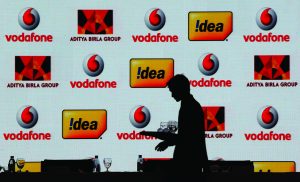 Due to the ongoing slowdown, companies with high debts are likely to be done in and face trouble in future. The impact of slower economic expansion might be more pronounced on companies with heavy debt because earnings at these companies are more likely to miss estimates, putting a question mark on financial projections and even survival in the long run.
Due to the ongoing slowdown, companies with high debts are likely to be done in and face trouble in future. The impact of slower economic expansion might be more pronounced on companies with heavy debt because earnings at these companies are more likely to miss estimates, putting a question mark on financial projections and even survival in the long run.
A study by McKinsey & Company has found that “Indian companies are under severe stress to service their debt obligations”. According to the study by McKinsey & Company on the indebtedness of Asian corporates the share of their long-term debt having an interest coverage ratio of less than 1.5 times of operating profits rose significantly over the past decade. The low interest coverage ratio shows that a large part of the earnings is going to service debt and any spike in interest rates could trigger a debt crisis in Asia.
The debt ratio gives company leaders insight into the financial strength of the company. Taking total debt and dividing it by total assets calculate this ratio. Total debt is the sum of all long-term liabilities and is identified on the company’s balance sheet. Most of the concentration of stressed debt in India is among industrial, energy and utilities sectors.
The frequent rate cuts by the Reserve Bank of India have cushioned some of the blow of high indebtedness among Indian corporates. The change in stance of the Reserve Bank of India, which has cut the repo rate by on so many occasions, has probably helped Indian corporates avoid a serious debt scare.
A high interest rate scenario might have seen Indian corporates struggle to repay their outstanding debt. The RBI’s four continuous rate cuts in 2019, and a low interest rate scenario in India have lowered the likelihood of a debt crisis in India. McKinsey study says that if the trade war between the USA and China continues and as a result foreign capital flows evaporate, there could be an increase in debt stress in Asia, which could impact India as well.
The fact is that there is insolvency risk in corporate sector in India because borrowings exceed market capitalization in case of more than 100 corporate houses. It may be a cause of concern and trigger stress amongst lenders is that the majority of advances or loans had been given to these stressed companies. Together these 100 companies owe close to 10 trillion, the highest during the last decade (see chart).
Top companies with very high debt include Reliance Industries Limited (total debt 1,61,720 crores), Power Grid Corporation of India (1,46,086 crores), National Thermal Power Corporation (1, 42,933 crores), Vodafone Idea (1,25,940 crores), Indian Oil Corporation (86,359 crores) and Bharati Airtel (83790 crores) etc.
Companies with very low market capitalization to debt ratio include Vodafone Idea (15.1 per cent), Tata Motors (32.7 per cent), Tata Power (30.4 per cent), Tata Steel (38.5 per cent), GMR Infrastructure (37.7 per cent), IRB Infrastructure (17.5 per cent), Sadbhav Engineering (18.1 per cent), Adani Power (48.1 per cent), Jindal Steel (30 per cent), and Rattan India Power (2.7 per cent), among others. This is based on companies’ m-cap at the end of August 23, 2019, and total debt at the end of financial year 2018-19.
In all, 54.5 per cent of all corporate loans are now with companies with inadequate m-cap, up from 46.5 per cent at the end of financial year 2018-19. These companies will now have to depend on internal accruals to manage debt servicing and fund operations, raising risk of a debt default or corporate failure if the economic downturn gets longer than anticipated. Access to fresh capital is essential for the survival of many of these financially stressed firms, given their poor financials including losses in recent years. Analysts expect defaults in return of borrowed funds in corporate India if slowdown persists.
For readers benefit, we analyze financials of some of the top corporate houses including those of Reliance Industries Limited, Vodafone Idea, Coffee Day Enterprises, Future Consumer, Deepak Fertilizer, Lemon Tree Hotels . Some of these companies have debt to EBITDA (earnings before interest, tax, depreciation and amortization) of more than 6 times.
Reliance Industries
Reliance Industries Limited ended last financial year (2018-19) with a net debt of 1,54,478 crore. Group Chairman Mukesh Ambani tried to assuage investor concerns over the group’s rising debt levels, saying the group has a clear roadmap to become zero net-debt company in 18 months.
Mukesh Ambani’s observation came at the 42nd Annual General Meeting. The company accumulated gross debt of more than 2.87 lakh crore, as it diversified into consumer-focused businesses in retail, telecom, refining and petrochemical business and e-commerce over the past few years. Will the group, be able to come out the debt trap as claimed by Ambani would be watched with interest?
Power Grid Corporation
State-owned Power Grid has got shareholders’ approval to raise up to 10,000 crore through issuance of bonds on private placement basis. As per a mandatory filing before the Stock Exchange, a special resolution was approved to raise the fund from domestic market. The resolution was moved in the annual general meeting on August 27. Its total borrowing till March 2019 totaled about 1,35,339 crores as per the balance sheet.
Vodafone Idea
Gross debt on Vodafone Idea as of September 30, 2019 was 1,17,300 crores including deferred spectrum payment obligations of 89,170 crores to the government. It had debt of 1.08 lakh crores at the end of 2018-19 and net loss of 14,600 crores. Technology in the industry is changing so fast that even before existing investments are recovered, the company will need to invest in newer technologies for survival.
Vodafone Group CEO Nick Read admitted that “The future of Vodafone’s India operations is critical as India had been a very challenging situation for a long time on the back of higher taxes and unsupportive regulatory environment”.
Bharati Airtel
According to a report by India Ratings the total debt of the top three telecom players — Reliance Jio, Bharti Airtel and Vodafone Idea — is a massive 3.9 lakh crores. Bharti Airtel the country’s third largest telecom operator slipped into red, incurring net losses of 2,866 crore for the first quarter of 2019-20, impacted by a continuing tariff war with Mukesh Ambani’s Reliance Jio and huge debt of close to 83, 790 crores.
The list of 100 most valued companies shown here point out how debt is eating into the business giants’ viability and making them more vulnerable amid the ongoing slowdown in the country.
View of Rating Agency
Rating agency Standard and Poor’s (S&P) has said in a note that “India’s finance companies are among the country’s largest borrowers. A substantial part of this funding comes from banks. The failure of any large non-banking financial company (NBFC) or housing finance company (HFC) may deliver a solvency shock to lenders.”
It said that this could have negative effects for credit growth and the economy. S&P said it believes that “Even when credit is available, the higher borrowing costs will likely hurt the profitability and growth of companies.”
The rating agency said this contagion runs the risk of spreading to real estate companies. “Finance companies are the largest lenders to this segment and any failure among such institutions could jeopardize credit flows to developers. The real estate companies are already grappling with weak demand, low sales, and high leverage. We saw this kind of contagion in Mexico after the global financial crisis. The default of Mexican non-bank mortgage lenders sent some large home builders into default as well,” it added.
Non-bank lenders have seen their source of funds suddenly dry up after a series of defaults by Infrastructure Leasing & Financial Services Ltd (IL&FS) that triggered a liquidity crisis. Banks and mutual funds reduced lending to NBFCs and HFCs, creating a cash crunch and forcing the shadow lenders to sell assets and cut back on new loans.
RBI take on debt
A recent analysis released by the RBI suggested that the failure of any top-five HFC or NBFC could result in the default of up to two banks. The Reserve Bank of India has also put caps on withdrawals by depositors after fraud in Punjab and Maharashtra Co-operative (PMC) Bank came into the fore. It has also issued a circular on dealing with defaulters that retained the original spirit of its efforts to discipline borrowers and banks and has also put the onus on lenders to act quickly to preserve the value of assets instead of waiting for directions. The circular has tightened the screws on those who missed loan repayments and scrapped all debt recast plans in favour of the Insolvency and Bankruptcy Code (IBC).
Experts say that when interest rates are on the rise, the company’s cost of borrowing funds also increases sharply. This means that servicing debt becomes increasingly expensive and it eats into a company’s profit. On the other hand, companies with low or zero debt are in a much better shape in such a scenario.
As the cash outflow through interest payment is not much, these firms are able to keep their costs to a minimum. In the current scenario, the revenue growth had turned anemic but the debt size is growing. In the past few years, while aggregate revenues grew merely 77 per cent, their debt doubled and interest payout went up 146 per cent.
Companies like Reliance Industries with their strong balance sheets and healthy cash flows have continued to service their debt. But a vast majority of companies — both big and small — have ended up in a debt trap. The bottom line is that in the current environment, debt-free companies offer a safer investment alternative. Investors will continue to prefer such businesses till the time that the economic recovery sets in.
letters@tehelka.com













